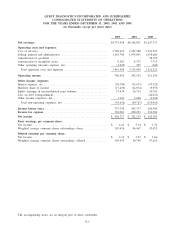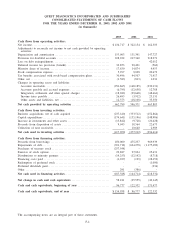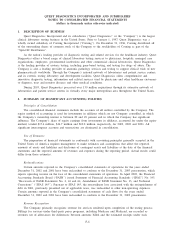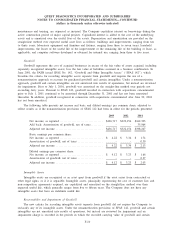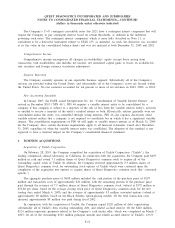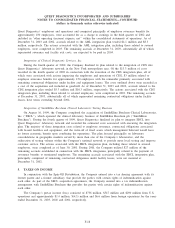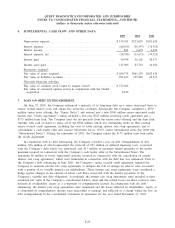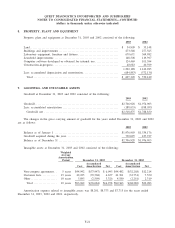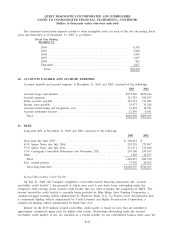Quest Diagnostics 2003 Annual Report Download - page 81
Download and view the complete annual report
Please find page 81 of the 2003 Quest Diagnostics annual report below. You can navigate through the pages in the report by either clicking on the pages listed below, or by using the keyword search tool below to find specific information within the annual report.
QUEST DIAGNOSTICS INCORPORATED AND SUBSIDIARIES
NOTES TO CONSOLIDATED FINANCIAL STATEMENTS—CONTINUED
(dollars in thousands unless otherwise indicated)
Investments
The Company accounts for investments in equity securities, which are included in “other assets’’ in
conformity with SFAS No. 115, “Accounting for Certain Investments in Debt and Equity Securities’’, which
requires the use of fair value accounting for trading or available-for-sale securities. Both realized and unrealized
gains and losses for trading securities are recorded currently in earnings as a component of non-operating
expenses within “other income (expense), net’’ in the consolidated statements of operations. Unrealized gains
and losses for available-for-sale securities are recorded as a component of accumulated other comprehensive
income (loss) within stockholders’ equity. Gains and losses on securities sold are based on the average cost
method.
Investments at December 31, 2003 and 2002 consisted of the following:
2003 2002
Available-for-sale equity securities ..................................... $26,195 $ 5,692
Trading equity securities .............................................. 19,168 14,808
Other investments .................................................... 12,598 9,744
Total .............................................................. $57,961 $30,244
Investments in available-for-sale equity securities consist primarily of equity securities in public
corporations. Investments in trading equity securities represent participant directed investments of deferred
employee compensation and related Company matching contributions held in a trust pursuant to the Company’s
supplemental deferred compensation plan (see Note 13). Other investments do not have readily determinable fair
values and consist primarily of investments in preferred and common shares of privately held companies.
As of December 31, 2003 and 2002, the Company had gross unrealized gains (losses) from available-for-
sale equity securities of $15.5 million and $(6.6) million, respectively. “Other income (expense), net’’ for the
year ended December 31, 2001 included a gain of $6.3 million associated with the sale of certain available-for-
sale equity securities. For the years ended December 31, 2003, 2002 and 2001, gains (losses) from trading
equity securities totaled $1.9 million, $(1.0) million and $(0.1) million, respectively, and are included in “other
income (expense), net’’ within the consolidated statements of operations.
Financial Instruments
The Company’s policy for managing exposure to market risks may include the use of financial instruments,
including derivatives. The Company has established a control environment that includes policies and procedures
for risk assessment and the approval, reporting and monitoring of derivative financial instrument activities. These
policies prohibit holding or issuing derivative financial instruments for trading purposes.
SFAS No. 133, “Accounting for Derivative Instruments and Hedging Activities’’ (“SFAS 133’’), as
amended, requires that all derivative instruments be recorded on the balance sheet at their fair value. Changes in
the fair value of derivatives are recorded each period in current earnings or other comprehensive income,
depending on whether a derivative is designated as part of a hedge transaction and, if it is, the type of hedge
transaction. Effective January 1, 2001, the Company adopted SFAS 133, as amended. The cumulative effect of
the change in accounting for derivative financial instruments upon adoption on January 1, 2001 of SFAS 133, as
amended, reduced comprehensive income by approximately $1 million.
Fair Value of Financial Instruments
The carrying amounts of cash and cash equivalents, accounts receivable and accounts payable and accrued
expenses approximate fair value based on the short maturity of these instruments. At December 31, 2003 and
2002, the fair value of the Company’s debt was estimated at $1.2 billion and $899 million, respectively, using
quoted market prices and yields for the same or similar types of borrowings, taking into account the underlying
terms of the debt instruments. At December 31, 2003 and 2002, the estimated fair value exceeded the carrying
value of the debt by $86 million and $77 million, respectively.
F-12



